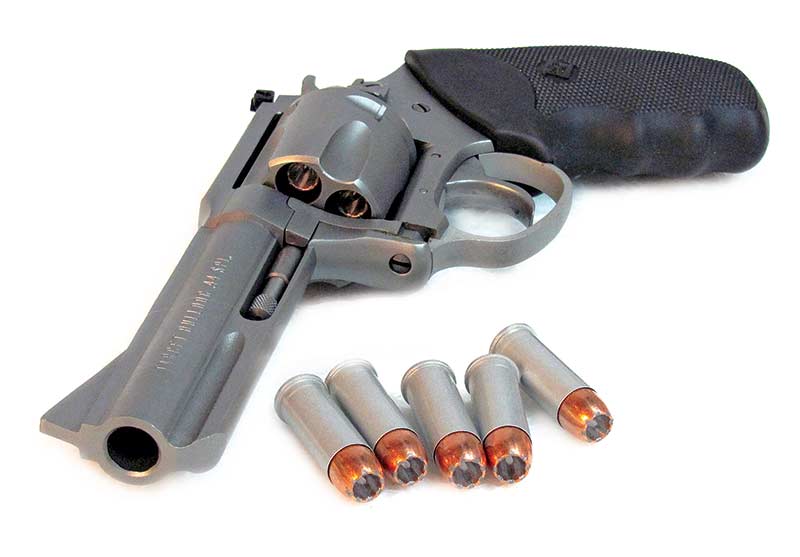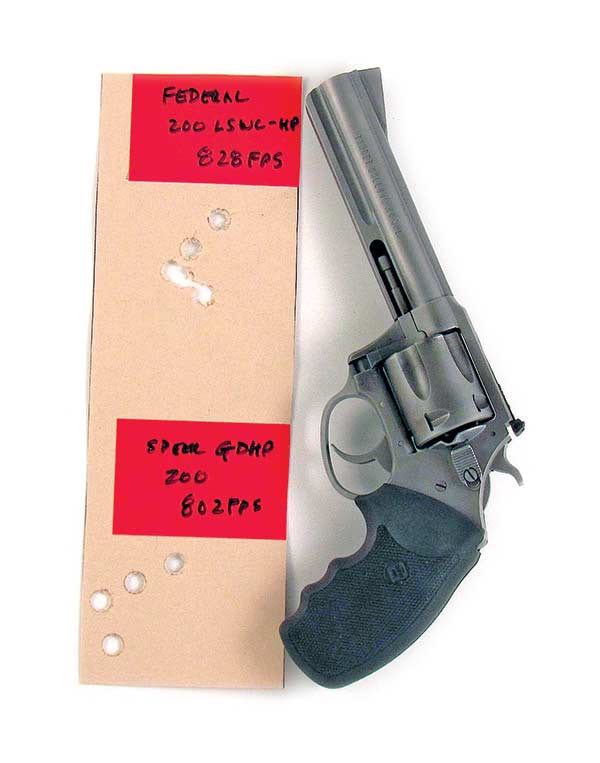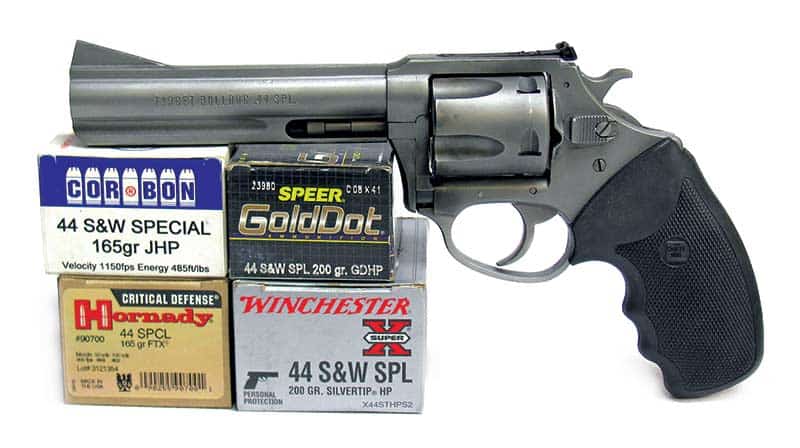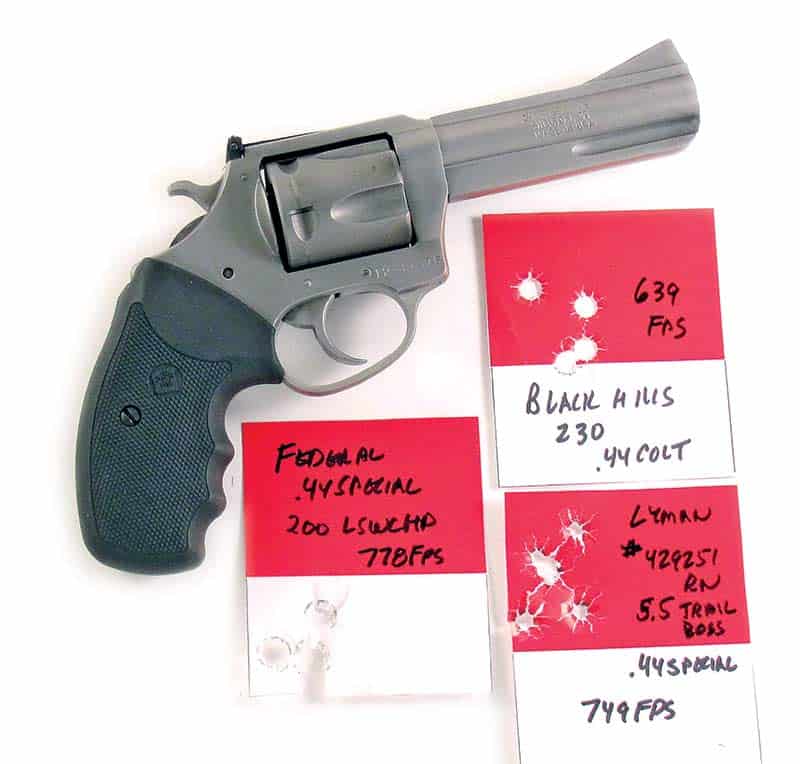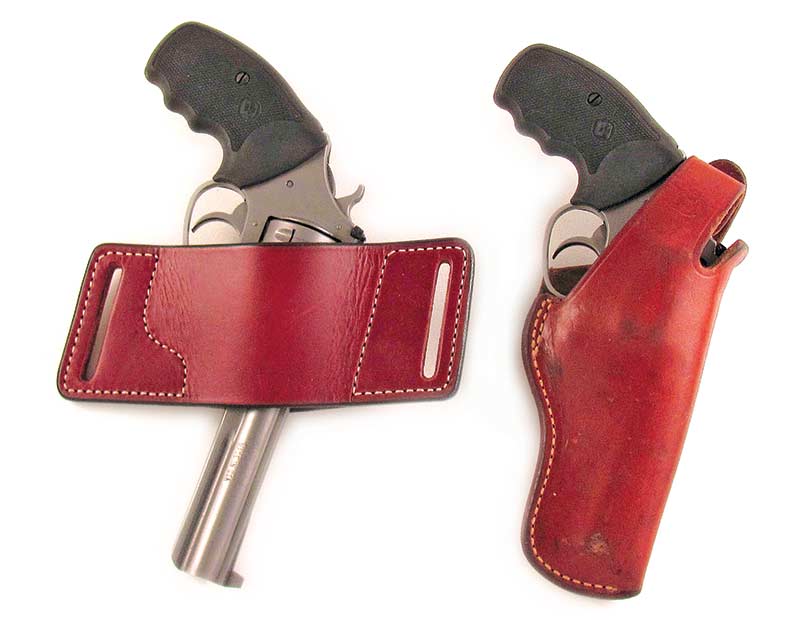During my high school years as I started reading the likes of Elmer Keith and then a little later Bob Hagel and John Lachuk I also acquired a deep interest and then even deeper affection for the .44 Special. In the mid-1960s Charter Arms brought out the first .44 Special Bulldog. It could not have come at a better time.
The .44 Magnum arrived in very late 1955 and started showing up in gun shops in 1956. There were many who foolishly felt the .44 Special was dead. Elmer Keith retired his, Skeeter Skelton traded his 4″ 1950 Target .44 Special in on a Smith & Wesson .44 Magnum with the same barrel length, and by the mid-1960s, both Colt and Smith & Wesson had dropped the .44 Special from their catalogs. The only way one could have a .44 Special was to find a used one, convert something like a .44-40 Colt Single Action to a .44 Special by fitting a new cylinder, or buy a Charter Arms Bulldog.
Charter Arms managed to keep the meagerly flickering flame of the Special alive, at least until Skeeter realized his mistake and admitted the 4″ .44 Magnum was too much of a good thing and traded it off, replacing it with another 4″ Smith & Wesson .44 Special. During the ensuing years, S&W’s attention to the .44 Special was sporadic at best. It wasn’t until our own Mike Venturino, Clint Smith and Editor Roy twisted arms at S&W (with the cooperation of Tony Miele there) a few years ago, a fixed-sight, N-Frame .44 Special became a catalog item for S&W once again.
All during this time, except for a brief closed doors session, Charter Arms continued to offer .44 Specials. As this is written .44 Special sixguns are available from Colt, Freedom Arms, Ruger, Smith & Wesson and Taurus. However, Charter Arms is currently the only manufacturer offering a small-frame, 5-shot, double-action .44 Special, with adjustable sights.
That First One
The original Charter Arms .44 Special in the 1960s was a blued, 5-shooter with a 3″ barrel. At the time it was one of my most-carried sixguns and logged many miles in the top of my boot. One year, now more than 30 years ago, we rented a motorhome and took a rare vacation with the kids, who were all in high school at the time — and the .44 Bulldog was stashed in the camper and it came in handy. Twice in my life a gun protected my young family, and in both cases the gun I had with me was the .44 Bulldog.
Sometime after introducing the original blued .44 Special Bulldog, Charter Arms came out with what they called a Target Model. It was an excellent idea, poorly executed. Somehow, someone thought they could come up with an adjustable-sighted .44 Special Bulldog by putting a shroud over a relatively thin barrel. Perhaps it could happen, however there has to be some way to anchor the shroud just as Dan Wesson did with the locking nut on the end of their barrels. Instead Charter Arms tried to hold the shroud on with one screw at the bottom of the shroud in front of the frame. It did not work well.
Modern Models
Today’s Target Bulldogs bear little resemblance to the original idea. The barrel is not shrouded but rather is a full under-lugged barrel properly screwed into the frame. Both 4″ and 5″ versions are available, complete with an adjustable rear sight and a ramp front sight. For my eyes, loads and hand, the front sight on both .44 Special Bulldogs was too tall, requiring the rear sight to be adjusted up too high to the point I feared I would lose the adjusting screw. The simple solution for me was to take metal off the top of the front sight.
The 5″ .44 Special Target Bulldog we tested worked perfectly and smoothly from the beginning, both double and single action. However the 4″ version had a little hitch in the trigger when fired double action and Tom, my gunsmith at Buckhorn, smoothed this out for me and reshaped the front sight.
Let’s take a closer look at the Target Bulldogs, which are basically identical except one has a 1″ longer barrel. Weights are approximately 20 and 22 ounces for the 4″ and 5″ Bulldogs, and that extra 2 ounces and 1″ longer barrel makes quite a difference in feel or balance or whatever we choose to call it. The shorter barrel seeming to nestle back in the hand while the longer barrel seems more muzzle heavy. These are both all stainless steel, except for the black adjustable rear sight assembly, 5-shot, double-action, very easy packing, weather-beating, go along anywhere revolvers.
Barrels are full under-lugged, rounded off at the bottom front for easy holstering, having an attractive scalloped cut-out running the length of the underlug in front of the cylinder ejector rod. It’s quite attractive and also removes a very slight amount of weight. The trigger is smooth while the hammer is serrated for easy single-action cocking. Both are also quite easy to operate double action.
The top of the frame is flattened with the rear sight assembly very nicely fitting inside the rear sight channel with no part of the assembly protruding above the frame. Grips are full wraparound, finger-grooved, checkered rubber which will not win any prizes as far as looks are concerned, however function-wise they are just about perfect for these little .44s.
With their 5-shot cylinders allowing the bolt cut to be placed between rather than directly under the chamber, Charter Arms .44 Special Bulldogs have always been stronger than any loads I would normally wish to use in them. They are certainly not .44 Magnums, but will handle .44 Specials and.44 Russian and .44 Colt rounds.
The latter two, designed for Cowboy Action Shooters, are quite pleasant to shoot and actually could be quite effective with their 200–230-grain bullets at nearly 700 fps from the longer barreled Bulldog, and 650 fps from the 4″ .44 Special.
The 5″ Bulldog was test-fired at 20 yards with the .44 Russian loads from both Black Hills and UltraMax grouping in 11/8″. With the shorter barrel I shot at a more realistic self-defense distance of seven yards, with the Black Hills 230-grain .44 Colt load grouping in 3/4″. So these loads not only shoot easily they are more than adequately accurate.
Defensive Loads
Switching to more serious .44 Special hollowpoint loads saw the Federal 200-grain lead SWC-HP clock out at 825 fps, with a 20-yard group of 7/8″ from the longer Bulldog and 775 fps and 3/4″ at seven yards from its smaller brother. Winchester’s 200-grain Silvertip JHPs do 766 fps and 11/4″ from the 5″ Special. For those wanting a heavier bullet, the Winchester 240-grain lead flatpoint does well over 700 fps.
My most-used .44 Special load consisting of the RCBS #44-250 Keith bullet over 7.5 grains of Unique clocks out at over 1,000 fps in the 5″ Bulldog which is quite a bit of energy coming from the barrel of such a small sixgun. The original .44 Special load from over 100 years ago can be duplicated with the Lyman round-nosed #429251 bullet over 5.5 grains of Trail Boss. This load does 750 fps and delivers 1″ groups from the 4″ Bulldog.
Both Speer and Hornady offer self-defense loads for the .44 Special, with the latter Critical Defense version a 165-grain JHP with a muzzle velocity over 1,000 fps, while the Speer 200 Gold Dot is at 800 fps and designed to expand at .44 Special velocities. Either one should be a good choice.
Keepers
I definitely like both of these stainless steel Bulldogs and they will not be going back. These little Charter Arms revolvers will find duty outdoors or in vehicle carry. Bulldogs definitely have a serious application, however sometimes we just need plain and simple fun shooting.
With these Bulldogs I can see this means .44 Russian and .44 Colt loads used for big-bore plinking along with the duplicated original .44 Special roundnosed load. There was a time in my life I felt everything had to be loaded full bore. Thankfully those days are passed and I can also shoot for enjoyment. Getting smarter is one of the few benefits of getting older.
